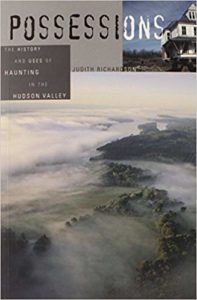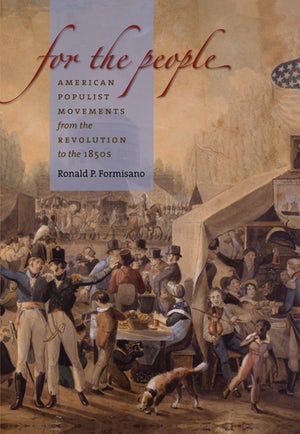One of the most powerful effects of Judith Richardson’s Possessions, The History and Uses of Haunting in the Hudson Valley is that it makes you notice the ghost stories in your own locale. In a graveyard on the northeast perimeter of my town, for example, a huge, black statue of an angel has fascinated and frightened generations of children. Strange events occur in her vicinity, and stories have grown up about what happens to people who encounter her alone after dark. Anyone who stays for long in this transient college town hears eventually of “the black angel” and makes a pilgrimage to the graveyard to encounter her face. There are many ways of accounting for the angel’s spookiness: her extravagant size; her evocation of wealth; her location in a graveyard in the older, formerly working-class and Catholic side of town; and the racial history her “spooky” face may or may not invoke in an upper-Midwestern community sixty miles from the Mississippi. What Richardson’s book teaches is that a local haunt like the black angel is alive, continually invested with narrative and visited regularly by children who dare each other to sit at her feet in the dead of night. Such “shimmering” sites are embedded deeply in time, layered with often-contradictory messages, and inseparable from place. Possessions reveals how the warp and weave of continuous historical change, environment, social opportunity, and social constraint work to structure the meaning of such a haunt. Richardson would say that Iowa City’s black angel possesses and occupies us, while we possess her as a kind of inheritance from beyond the grave.
Ghosts have enjoyed a renaissance of sorts in literary and cultural criticism. Recent books by Kathleen Brogan and Renee Bergland confront the relationship between ghosts and the historical violence of slavery and colonialism, while studies of the gothic by Julia Sterne, Teresa Goddu, and John Carlos Rowe connect the theme of haunting in American literature to the repressed memory of war, the oppression of women, and the wider horizon of U.S. imperial expansion. Richardson obviously shares the concerns and, to some degree, the methods of these critics. What sets her history of Hudson Valley ghosts entirely apart from them is its respect for the materials of folklore and its nuanced insistence upon locale or “place.” Possessions is not, however, a work of folklore. Instead, it teases out local voices from a comparatively cosmopolitan archive that includes the folklore records compiled in the 1940s at the State College of New York at Albany, as well as the tales of Washington Irving, and the abundant print literature produced by regional journalists, novelists, antiquarians, tour-book and travel writers.
Possessions’ four chapters narrate discrete episodes in the history of Hudson Valley haunts. Chapter 1 reviews the long career of Irving’s ghostly Dutchmen and headless horsemen in the valley. Literary scholars will find little new in Richardson’s readings of The Sketch Book or Tales of a Traveler. Her point is the historical one that Irving both predicted and prompted the development of ghost stories in the Hudson Valley until it was unclear who came first, Irving or his ghosts. In 1897, for example, one immigrant Irishwoman, living near a burned-out factory in Tarrytown, reported “a big, black, shadder-like” apparition, “widout any head, an’ him on horseback at that” (78). As this episode suggests, the region’s ghosts frequently register racial tensions, a fact that is closely pursued in chapter 2, in which Richardson recounts the colorful career of the ghost of Anna Swarts, an eighteenth-century servant girl killed mysteriously by her master. Between 1762 and 1940, Swarts’s ghost would assume shifting racial identities under changing historical and literary conditions. Chapter 3 goes on to enumerate the sheer ethnic variety of the valley’s ghosts in the only chapter that does not treat a single episode or author but surveys the Indian ghosts, Dutch-explorer ghosts, Revolutionary-War ghosts, and “worker-ghosts” that haunted the valley from colonization to the height of industrial development. Chapter 4 concludes the book with the New Deal politics of Maxwell Anderson’s 1937 play High Tor, in which the region’s ghosts assemble to fight the quarrying machines of the New York Trap Rock Company as they arrive to destroy High Tor, a landmark mountain inhabited by a real-life Dutchman named Elmer Van Orden.
Possessions is held together by a loose chronological development in which the growth of industry and tourism figures heavily. But it is more centrally unified by Richardson’s analysis of “the productive ambivalence” (83) or the political and ideological shiftiness of Hudson Valley ghosts. Ghosts, she argues, typically emerge from episodes of violence or oppression whose facts are historically hazy. In turn, the ghostly residues of these events are themselves unstable (or shifty) and can be easily made to serve a variety of political uses. The ghost of Anna Swarts is a case in point.
Swarts was tied to the tail of her master’s horse and dragged to her death. Further details of her murder or torture are lost to the record. Swarts’s master, a local landowner named Salisbury, was acquitted of murder in 1762. But his servant’s ghost went on to have a long career. In the 1820s, she appeared in tattered garments behind a spectral horse, as a howling skeleton, and as a female figure shrieking in the rocks “with a lighted candle upon each finger” (91). Years later in The Sutherlands, an antislavery novel of the 1860s, she is represented as a mixed-blood, Native- and African-American girl and given the combined Dutch (Annatje) and Cooperesque name of Nattee. Swarts’s ghost assumes other racial–and racist–permutations in the era of Jim Crow, until her career finally ends in the 1940s with the folklore records at Albany, where one local woman reports that “everyone” knew Anna Swarts was a Negro slave who had run away. The same woman testifies that a descendent of Salisbury (whose family still lived in the area) contended that Swarts was simply an indentured German girl who tried to run away, but was “quite naturally” led back “to the paths of industry.” Here, Richardson argues, Swarts’s racial assignment breaks down according to class. On one hand, her identity as a slave gives voice to the history of inequality and injustice in the valley by recalling its slave-owning past. (Slavery was legal in New York until 1827.) On the other hand, the man who protests that Swarts was a poor, German girl who did not know her “place” makes Salisbury’s servant complicit in her own death. Two centuries after her death, Swarts’s ghost continues to inhabit the shifting fissures of race, gender, and class division, and to serve the interests of others: “The main work of haunting is done by the living . . . Dorothea Swarts’ ghost is itself haunted” (123-4).
Readers who want to nail down the specters that have haunted the Hudson will find themselves frustrated by the sheer number of explanations Richardson offers for their vitality. Her ghosts are nurtured by the craggy mountains and mists of the Hudson River itself, along with such ideological and aesthetic matters as gothic and romantic taste in literature and landscape painting. But, Richardson insists, they are equally nourished by the waves of immigrants who accompanied the industrial development of the region, bringing layers of narrative and folk traditions of their own to bear on the scene. Richardson is careful to situate ghosts historically. She sets the shifty politics of worker-ghosts within the context of the valley’s industrial transformation (through turnpikes, factories, quarries, and reservoirs) in a discussion that is historically specific and nuanced. By contrast, her treatment of the region’s Indian ghosts elides their historicity. Native American groups of the early Hudson Valley are neither adequately named nor situated, with a few slight exceptions, such as “the last of the Tappans” (144).
Richardson is otherwise a sharp reader of the fluid interplay of history, legend, and literary culture. This is particularly evident in her analysis of High Tor, in which the ghosts of the valley are seen to produce real-world effects. Anderson’s play, with its battle between ghosts and a New York quarry company, eventually sparked a successful movement to preserve High Tor, and the mountain was integrated into the Palisades Interstate Park system. But in keeping with her focus on spectral “shiftiness,” Richardson is primarily interested in the ambivalent social and political outcomes of New Deal historical conservation movements. She argues that the museums and historical houses that linked historic sites to the new park systems of the 1940s were part of a cosmopolitan enterprise that, like the reservoirs built in the same period, involved a loss of place for individuals and whole towns, setting the vision and wealth of those who preserve and collect regional haunts against the lives of the region’s less cosmopolitan inhabitants.
Ultimately, for Richardson, it is the sheer pace of change in the Hudson Valley that explains its haunted history. From one point of view, the ghostly formations of the region are the residue of economic, colonial, and racial conflict from the 1670s through the mid-twentieth century. At the same time, however, they give voice (moans, groans, rattles) to events and lives that are irretrievably lost to the archive. Richardson refers to the persistent haze of historical elision as a “problem of historical memory amid progress,” “a sense of social and historical tenuousness,” and “a loss of essential information” (7, 27, 64). Yet it is precisely the wispy ambiguity of Hudson Valley ghosts that has made them so useful to divergent ideological interests over time, beginning with Irving, who “discovered a way to work not just the history but even more the elision of the past in the Hudson Valley” (51).
Possessions is not directly concerned with the psychological or political mechanisms of repression and displacement. Nor is it consistently concerned with the connection (promised by the title) between ghosts and property–the systematic quality of relations of ownership and exclusion that, given the long history of capitalist development in the valley, is perhaps more central to its archive than Richardson is willing to acknowledge. Straddling history, literature, and folklore, she excavates the layers, contradictions, and misty gaps in an archive of spectral traces where more is (hauntingly) lost than revealed. Possessions is an unsentimental and moving book about loss. It is also implicitly a reflection upon the loss of “the local” itself under the pressures of economic development, even while it works against that story line, to reveal how past and present continue to meet (somewhere between memory and knowledge) in “place.” With a kind of hard-edged pathos then, Possessions opens a door not only onto a regional New York archive but also onto what it might mean to be somewhere, to situate and to find oneself in one’s own haunted place.
Further Reading:
Other recent work on ghosts and the gothic in American literature and culture include Renee Bergland, The National Uncanny: Indian Ghosts and American Subjects (Hanover, N.H., 2000); Kathleen Brogan, Cultural Haunting: Ghosts and Ethnicity in Recent American Literature (Charlottesville, 1998); Julia A. Sterne, The Plight of Feeling: Sympathy and Dissent in the Early American Novel (Chicago,1997); Teresa A. Goddu, Gothic America: Narrative, History, and Nation (New York, 1997); John Carlos Rowe, Literary Culture and U.S. Imperialism: From the Revolution to World War II (New York, 2000).
This article first appeared in issue 4.3 (April, 2004).
Laura Rigal teaches in the departments of English and American studies at the University of Iowa and is the author of The American Manufactory: Art, Labor, and the World of Things in the Early Republic (Princeton, 1998). She is currently at work on History’s Fictions: Imperial Regions and the Emergence of American Literary Culture.



















